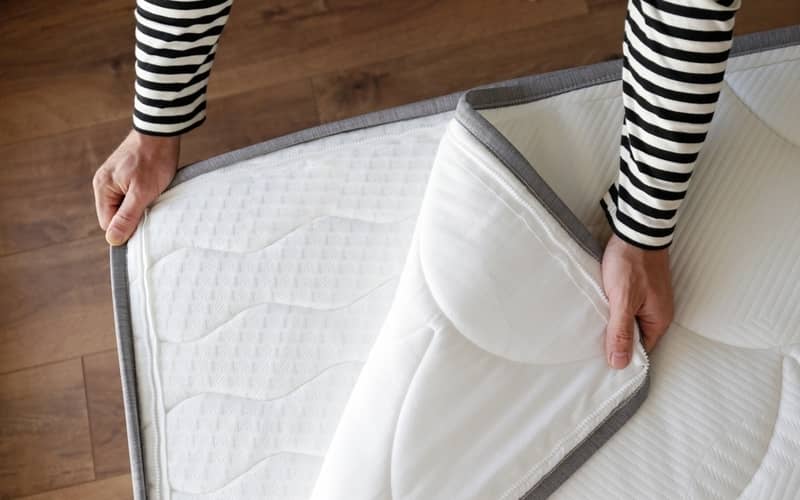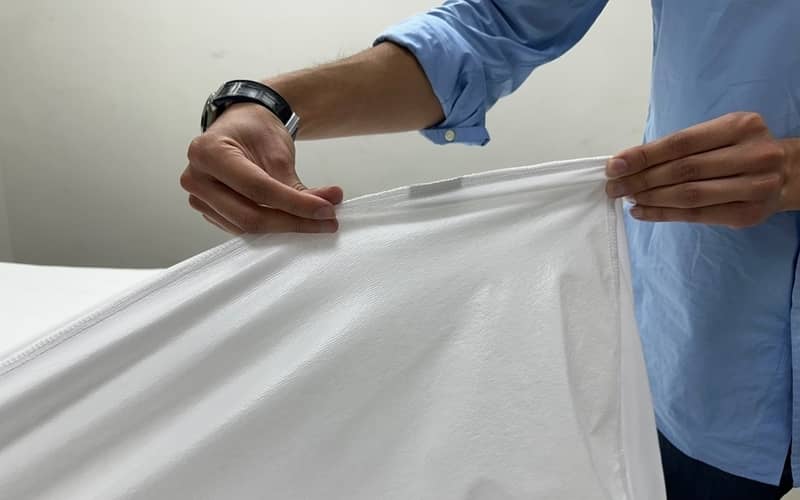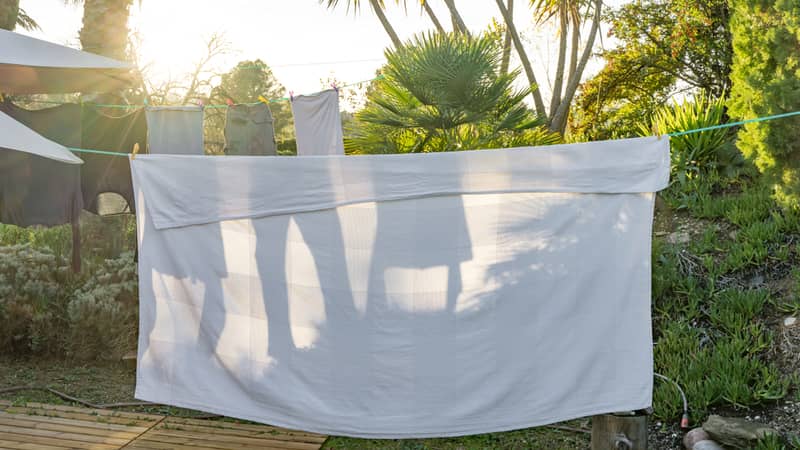Whatever your sleep routine is, the humble mattress protector is an unsung bedtime hero.
A good mattress protector keeps your mattress clean and hygienic. It can even prolong the life of your mattress by keeping out dirt and stains.
However, even if the mattress protector goes under the sheets, it still gets dirty! It’ll accumulate sweat, body oils, and other dirt over time, so you need to wash it regularly.
How to wash a mattress protector? Usually, you can machine wash mattress protectors with mild detergent and a warm wash cycle (no drying!).
Don’t overlook that mattress cover just because you can’t see it! After all, clean bedding is a key part of a good night’s sleep.
How Often to Wash | How to Wash | How to Dry | Removing Stains | Maintaining a Mattress Protector
What’s a Mattress Protector For?

Don’t confuse a mattress protector with a mattress topper!
A mattress topper (or mattress pad) is a thin cushion, usually made of cotton, down, or foam. It sits on top of a mattress and is used to improve sleep comfort or add padding if your mattress is worn out.
A mattress protector (or mattress cover) is a thick fabric sheet, usually with a waterproof layer. This cover goes over the mattress but under the bed sheets.
There are typically three types of mattress protectors:
- Elastic straps: A flat fabric sheet with elastic straps on the corners to anchor it to the mattress
- Fitted design: Similar to a fitted sheet, with extra fabric that tucks under the mattress
- Zippered design: Covers the entire mattress like a pillow case, with a zipper to close it
A mattress protector – as the name implies – protects your mattress from dead skin cells, dust mites, bed bugs, and other dirt. A waterproof protector can prevent stains from drinks, blood, and urine.
Moreover, a good cover means you don’t have to clean your mattress as frequently!
How Often to Wash a Mattress Protector
Since the mattress protector goes under the sheets, it doesn’t need cleaning as frequently. Wash your mattress protectors every 2 months.
You can do some spot-cleaning if you see minor stains between washes.
If you have allergies or sweat a lot, wash the mattress protector more frequently – every 2-4 weeks. Try to time it with how often you wash your bed sheets!
However, if someone has been sick or has spilt a drink, wash the mattress protector immediately.
How to Wash a Mattress Protector

Before anything else, check your mattress cover’s care label! This will tell you if the protective mattress cover is machine-washable or not.
For a waterproof mattress protector, the care instructions will let you know what cycle to use so you don’t damage the waterproofing.
Do not dry clean a mattress protector unless the label allows it. The chemicals can damage the cover’s material, especially the waterproof layer.
Machine washing your mattress protector
If the label allows it, you can wash a mattress protector in a washing machine. For a zippered mattress cover, close the zipper so it doesn’t snag or damage anything.
Pre-treat stains if necessary. Use an appropriate laundry stain remover or a homemade solution of hydrogen peroxide and dish soap.
Load your mattress protector inside the washing machine. Make sure not to overload the machine or you won’t get a thorough wash.
To wash a synthetic, bamboo, or cotton mattress protector, use a mild detergent and a warm water cycle (about 40ºC). Don’t use hot water cycles since this can shrink the cover or damage any waterproof material.
For a down mattress protector, use a dedicated down wash or a low-suds detergent. You should only machine wash a down cover if you have a front-load washer or a top-loader with an impeller.
Run two rinse cycles to remove any remaining detergent from the fabric. This is especially helpful for allergy sufferers or people with sensitive skin.
Skip the fabric softener – it can leave residue on the fabric. And absolutely no bleach!
Hand-washing your mattress protector
If your mattress protector is not machine-washable, you can still hand-wash it!
You can hand-wash a down mattress protector like you would a doona, since it causes less damage to the down filling.
After removing the protector, take it to the bathroom or outside. Mix some mild laundry detergent in warm or cold water.
Dip a non-abrasive sponge into the soapy water, then wring it out. Gently scrub the top layer of the mattress protector, paying special attention to the edges or stained areas.
Rinse off any residue with a fresh sponge dampened with clean water.
How to Dry a Mattress Protector After Washing It

It’s best to air-dry your mattress protector! This helps the cover retain its shape, plus the air circulation and sun help keep it fresh.
Hang the mattress protector over several lines, ideally in a sunny spot. Leave it for a few hours to completely dry.
Air drying in the sun doesn’t just remove all the moisture, it can also lighten fabrics and prevent mildew growth.
If you’re unable to dry the cover outdoors and the label allows it, you can tumble dry it on a low heat setting. For a down protector, toss in some dryer balls to prevent clumping.
Always check the label on a polyurethane or waterproof protector before drying. Too-high heat can damage the material and cause it to shrink or warp.
Never iron a mattress protector, especially a waterproof one.
Removing Stains on a Mattress Protector
A few mild stains here and there shouldn’t be a problem – it’s not like you can see the mattress protector, anyway!
However, stains like blood, urine, and spilt liquids should be treated ASAP to keep the mattress protector clean and hygienic.
How to clean pee out of a mattress protector
To get fresh urine stains and smells out of a mattress protector, sprinkle baking soda on the stained area ASAP. This will help neutralise the uric acid and remove odours.
Let that sit for 20 minutes, then wipe off the residue. Follow with a solution of equal parts white vinegar and water to soak the stain.
For old urine stains, go straight to applying the vinegar solution or use an enzyme-based cleaner.
Run water through the stain to rinse, then wash the mattress protector as usual.
How to get blood out of a mattress protector

You can get blood out of a mattress protector with the same methods you use to get blood out of sheets!
Remove the mattress protector and soak the stained area in a solution of salt and cold water. You can also dampen the stain with cold water, then sprinkle on a generous amount of salt.
Let the mattress protector sit in the solution for up to 30 minutes. Blot the stained area with a soft cloth, then wash the mattress protector as usual.
For white or light-coloured covers, you can also use hydrogen peroxide.
If it’s a small stain, apply hydrogen peroxide with a soft sponge or cloth, and keep dabbing the area until the stain lifts.
For larger stains, use a spray bottle to apply the solution directly onto the stained area. Let it sit for 15 minutes, then rinse the stain with cold water and wash the mattress cover.
How to get tea out of a mattress protector
If you’ve spilt tea, coffee, or wine on your sheets, you’ll need to act quickly! The tannins in these drinks can set and become more difficult to remove.
Blot as much liquid as you can. Do not rub or you could push the stain deeper into the fabric.
To remove the stain, soak the affected area in club soda overnight, then rinse the cover and wash it in the morning.
Alternatively, mix equal parts white vinegar and water, plus a few drops of dish soap. Apply the solution with a soft sponge and let it sit for 20 minutes (or overnight for older stains).
Wash the mattress protector afterwards.
How to get yellow stains out of a mattress protector
Yellow stains on a mattress protector typically come from sweat and other bodily fluids. Some fabrics also turn yellow over time as the material ages.
To lighten or remove yellow stains, soak the mattress protector overnight in an Oxiclean solution — make sure to use one that’s appropriate for either white or coloured fabrics.
You can also make a homemade laundry soaker with 1 cup baking soda, 2 cups sodium percarbonate, and 2 cups washing soda.
Dissolve 2-4 tbsp into a tub of warm water, then soak the mattress protector for a few hours.
Do not use the homemade stain remover for a cover that has a zipper or other metals.
Tips on Maintaining a Mattress Protector

Besides proper cleaning methods, here are some tips to maintain your mattress protector and help it last as long as possible.
Cleaning different materials of mattress protectors
Make sure you choose an appropriate wash cycle for your mattress protector. This ensures you don’t damage the material and prolong the cover’s lifespan.
For a waterproof mattress protector that’s machine-washable, use a gentle cycle with cold or lukewarm water. Otherwise, hand-wash it with some mild detergent.
For a down mattress protector, opt for a cold cycle so you don’t damage the filling. Do not machine wash it if you have a top-load washer with an agitator, as it could tear the fabric or damage the filling.
What temperature to wash a mattress protector
When washing most mattress protectors, a warm cycle at about 40ºC is fine! This will clean the fabric and remove body fluids without damaging the fabric.
For a waterproof protector, wash it between 30-40ºC so you don’t damage the waterproof layer.
Special mattress protectors (such as allergy-blocking ones) can typically handle high heat. Wash these in hot water (at least 60ºC) to kill bacteria and germs.
When to replace a mattress protector
Even with correct washing and proper maintenance, your mattress protector will wear out with use!
Whenever you strip and wash a mattress protector, check for rips, holes, and other damage. If they’re not easily repairable, it may be time to replace the protective mattress cover.
Any damage to the waterproof layer also means a mattress cover replacement.
For a zippered cover with a damaged zip, see if you can have it fixed! If not, it’s best to replace the cover – if it can’t close, it won’t be effective at keeping dust mites and other allergens out.

